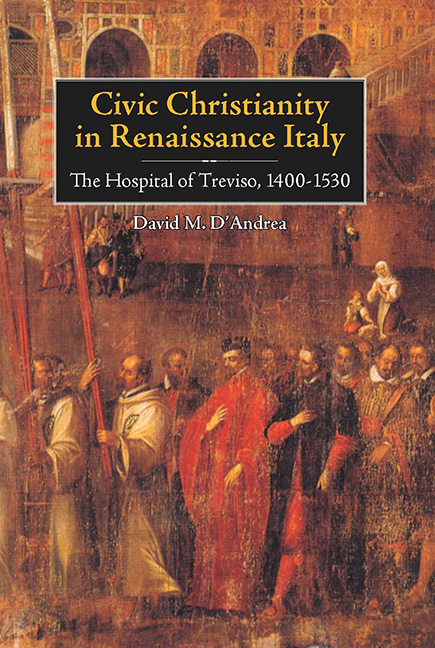Book contents
- Frontmatter
- Contents
- List of Illustrations
- Acknowledgments
- List of Abbreviations
- Notes to the Reader
- Introduction
- Chapter 1 The City of God
- Chapter 2 The Confraternal Family
- Chapter 3 The Bonds and Bounds of Charity
- Chapter 4 Medical Care and Public Health
- Chapter 5 Instruction for This Life and the Next
- Chapter 6 Crisis and Reform
- Notes
- Bibliography
- Index
- Frontmatter
- Contents
- List of Illustrations
- Acknowledgments
- List of Abbreviations
- Notes to the Reader
- Introduction
- Chapter 1 The City of God
- Chapter 2 The Confraternal Family
- Chapter 3 The Bonds and Bounds of Charity
- Chapter 4 Medical Care and Public Health
- Chapter 5 Instruction for This Life and the Next
- Chapter 6 Crisis and Reform
- Notes
- Bibliography
- Index
Summary
First we state and order that the confraternity and school of Blessed Mary of the Battuti of Treviso that now is and will be, is and must be to the praise of God our Creator and to the Glorious Virgin Mary his mother, in whose honor the said fraternity and school is named and is to be called . . . and that the brothers are and are known to be subjects of the jurisdiction and protection of the commune of Treviso.
—Statutes of Santa Maria dei Battuti (1400)
The statutes of Santa Maria dei Battuti of Treviso were typical of seemingly countless brotherhoods in Renaissance Italy, where the devout gathered in voluntary association and dedicated their prayers and works to the honor of God, the Virgin Mary, and the saints. Scholars have increasingly studied confraternal associations, at the intersection of personal devotion and public service, as a key element of Italian Renaissance society. Their organization, activities, wealth, and involvement in the community offer various ways to investigate the nature of Renaissance political and religious life. Confraternities and their hospitals offer a view of broad Christian values refracted through the experience of each local community. Despite their common organizational principles and ubiquity in Renaissance society, confraternities remained intensely local. The important geographic location of Treviso and the unique historical development of Santa Maria dei Battuti place this confraternity at the confluence of three major historiographical currents: Renaissance religion, public charity and relief, and the territorial state. How a powerful provincial confraternity responded to the spiritual and material needs of the local community and mediated the regional objectives of the capital city will provide valuable insights into the role of religion in Renaissance states.
Italian Renaissance studies have long labored under the influence of nineteenth-century constructs that depicted the Renaissance as the birth of the modern secular age. In the last few decades myriad studies of Renaissance religion have challenged this basic assumption.
- Type
- Chapter
- Information
- Civic Christianity in Renaissance ItalyThe Hospital of Treviso, 1400–1530, pp. 1 - 12Publisher: Boydell & BrewerPrint publication year: 2007



